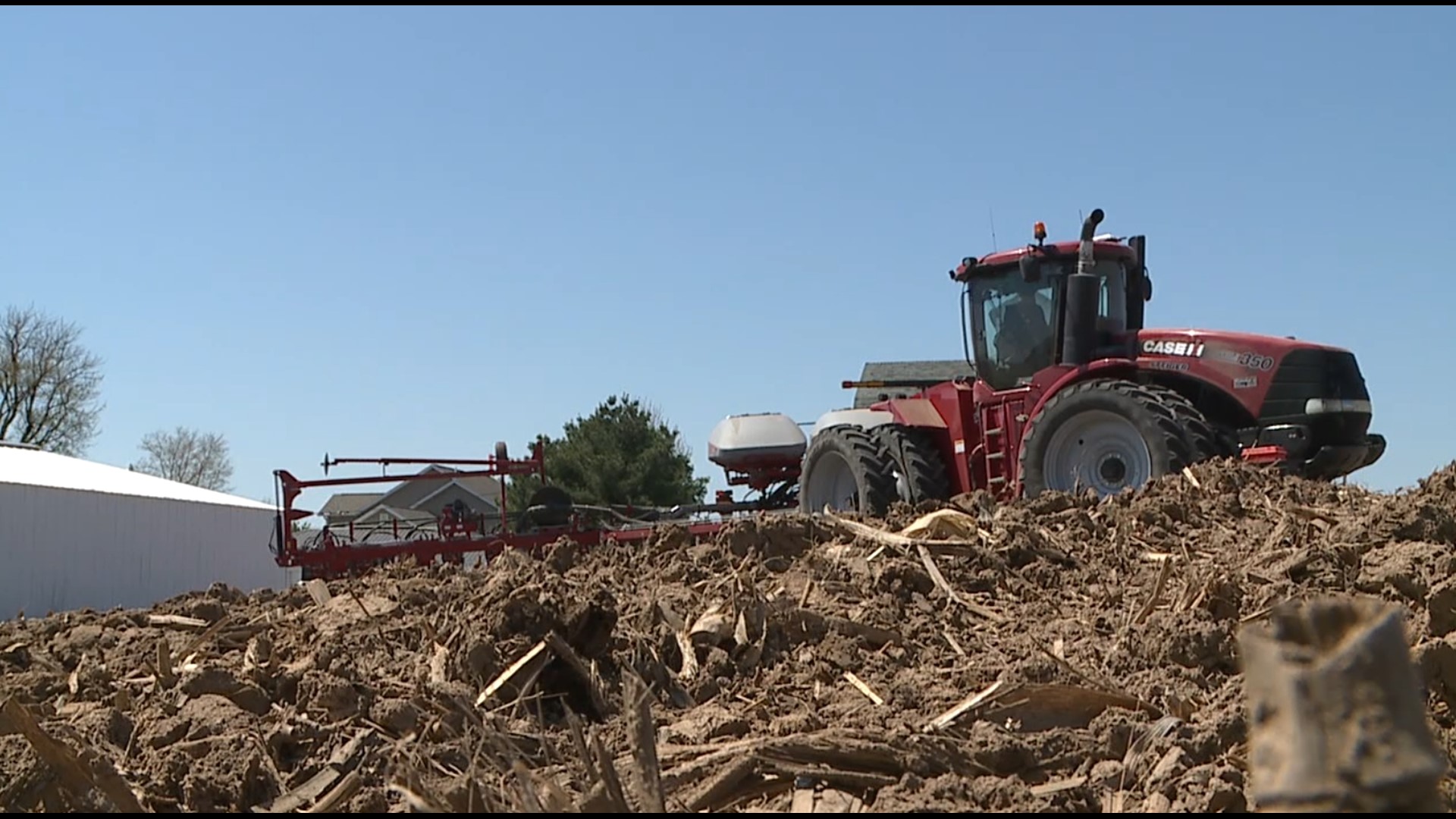MOUNT CARROLL, Ill. — Another planting season is upon us and, like always, a new year brings its own unique challenges. So far, it's been a cool and dry spring. For area farmers, that means soil temperatures aren't ideal.
"We got spoiled there a little bit in the beginning of April with some 70°, 80° weather. But we've been sitting ever since," laughed Jeremy Flikkema.
Flikkema and his family farm around 3,500 acres of corn, soybeans and wheat up in Carroll County, IL.
In a perfect spring, farmers would wait for soil temperatures to reach at least 50° before planting. If the ground is any cooler, the seeds have trouble germinating and might not grow a plant up out of the ground, leaving it susceptible to pests, bacteria, fungal infections and more. Such a condition is known as seedling disease.
But this year, Flikkema decided to hit his fields just before that magic threshold.
"We're probably pushing out a little earlier, but as long as the temperatures are increasing and the sun's out and the ground is fit, moisture levels are good, we'll go right at it," Flikkema said. "A little bit of heat and a little bit of sunlight really helps."
It's certainly a risk anytime you plant a crop in the ground. However, the danger is heightened this year as input costs are soaring. Everything from seed to fertilizer, chemicals to equipment, and even hired hands and fuel are all at a premium.
"This year is the most expensive crop we've ever planted," Flikkema said. "I think we're up 23% from last year to this year."
Three years ago, it cost Flikkema anywhere from $700-800 an acre to plant his crops. This spring, that's up to $1,100-1,200 an acre.
Still, Flikkema is staying optimistic. His soil moisture levels are five inches over normal. And despite a cooler start, his planting is virtually right on schedule.
"(Planting) is the same process, it's just there's a twist on it every year. No year's the same... but it kind of is," Flikkema laughed.
90 miles south, Mercer County farmer Chad Bell opted to plant soybeans first, which are a little more resistant to seedling disease.
"We don't like to plant into cool and wet soil conditions. Luckily, this spring it's been more cool and dry," Bell said. When News 8 caught up with him, he was laying a field of beans into soil measuring around the mid-40s. "The risk is much lower planting cooler and dry versus cool and wet or warm and wet."
While he was able to squeeze some planting in during a warm stretch around Easter, Bell said by the last week of April, he knew he had to get going.
"It doesn't really feel right to plant right now with these cold soil conditions. But the calendar says it's time and warmer weather has to be coming soon," Bell said. "After we start getting into the first and second week of May then our top yield prospects start kind of winding down and we start losing a little bit of yield as the calendar slips away from us."
Much like his northern neighbor, Bell is also balancing rising input costs around his farm. But on a lighter note, he's also seeing favorable soil moisture.
"Subsoil moisture we're sitting pretty good. The tiles are still running, so that means there's excess water down three to four feet deep. Topsoil we're dry, but this time of year, I'll take that."
It's all familiar territory to Western Illinois Pioneer field agronomist Brad Mason. He's seen a dramatic increase in customers moving ahead with soybeans when planting conditions aren't quite ideal yet.
"My area north of Galesburg is actually heavier planted in soybeans than they are in corn. 10 years ago, that would never happen," Mason said.
Throughout this spring, he's been reminding his customers to plant by the soil conditions, not the calendar. Nine times out of ten, he says if the soil is working up nice and planting good, it gets farmers out of a lot of other spring-time issues.
"As soon as you plant the seed in the ground, there's a biological clock that starts ticking," Mason said. Around here, farmers want corn seeds growing up and out of the ground within 21 days of planting and soybeans within 30. "What's weird about it a lot of the soil conditions are as good as they've ever been. We just don't have the heat."
But 70 miles to the west, Louisa County farmer Paul Gieselman isn't letting himself get too stressed out.
"I'm full of confidence and optimism... as of right now," Gieselman laughed. "I'd rather be a little late planting and have quick emergence than be too early and have it get nipped by frost."
He also elected to begin with soybeans this year while he waited for more ideal corn-planting conditions. Last summer, his area of southeastern Iowa experienced heavy drought. But so far, his soil moisture has been conducive to planting.
In fact, he says even having the choice to weigh, over planting earlier in a cooler April or waiting and hoping for a warmer May, is a luxury in the world of farming.
"I'm not trying to stress about things I can't control," Gieselman said. "I'm forever optimistic. It's a great start so far."
As of the time of this article, the Department of Agriculture reported 29% of Iowa's corn crops and 16% of the state's soybeans had been planted. Over in Illinois, 40% of corn and 39% of soybeans had been planted.
Watch more news, weather and sports on News 8's YouTube channel

